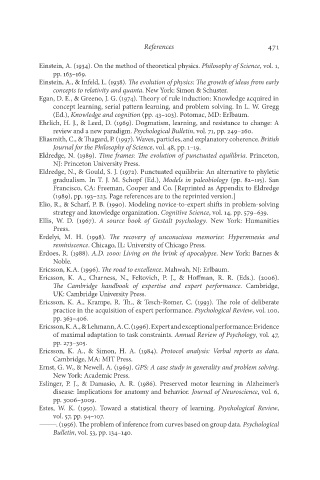Page 488 - Deep Learning
P. 488
References 471
Einstein, A. (1934). On the method of theoretical physics. Philosophy of Science, vol. 1,
pp. 163–169.
Einstein, A., & Infeld, L. (1938). The evolution of physics: The growth of ideas from early
concepts to relativity and quanta. New York: Simon & Schuster.
Egan, D. E., & Greeno, J. G. (1974). Theory of rule induction: Knowledge acquired in
concept learning, serial pattern learning, and problem solving. In L. W. Gregg
(Ed.), Knowledge and cognition (pp. 43–103). Potomac, MD: Erlbaum.
Ehrlich, H. J., & Leed, D. (1969). Dogmatism, learning, and resistance to change: A
review and a new paradigm. Psychological Bulletin, vol. 71, pp. 249–260.
Eliasmith, C., & Thagard, P. (1997). Waves, particles, and explanatory coherence. British
Journal for the Philosophy of Science, vol. 48, pp. 1–19.
Eldredge, N. (1989). Time frames: The evolution of punctuated equilibria. Princeton,
NJ: Princeton University Press.
Eldredge, N., & Gould, S. J. (1972). Punctuated equilibria: An alternative to phyletic
gradualism. In T. J. M. Schopf (Ed.), Models in paleobiology (pp. 82–115). San
Francisco, CA: Freeman, Cooper and Co. [Reprinted as Appendix to Eldredge
(1989), pp. 193–223. Page references are to the reprinted version.]
Elio, R., & Scharf, P. B. (1990). Modeling novice-to-expert shifts in problem-solving
strategy and knowledge organization. Cognitive Science, vol. 14, pp. 579–639.
Ellis, W. D. (1967). A source book of Gestalt psychology. New York: Humanities
Press.
Erdelyi, M. H. (1998). The recovery of unconscious memories: Hypermnesia and
reminiscence. Chicago, IL: University of Chicago Press.
Erdoes, R. (1988). A.D. 1000: Living on the brink of apocalypse. New York: Barnes &
Noble.
Ericsson, K.A. (1996). The road to excellence. Mahwah, NJ: Erlbaum.
Ericsson, K. A., Charness, N., Feltovich, P. J., & Hoffman, R. R. (Eds.). (2006).
The Cambridge handbook of expertise and expert performance. Cambridge,
UK: Cambridge University Press.
Ericsson, K. A., Krampe, R. Th., & Tesch-Romer, C. (1993). The role of deliberate
practice in the acquisition of expert performance. Psychological Review, vol. 100,
pp. 363–406.
Ericsson, K. A., & Lehmann, A. C. (1996). Expert and exceptional performance: Evidence
of maximal adaptation to task constraints. Annual Review of Psychology, vol. 47,
pp. 273–305.
Ericsson, K. A., & Simon, H. A. (1984). Protocol analysis: Verbal reports as data.
Cambridge, MA: MIT Press.
Ernst, G. W., & Newell, A. (1969). GPS: A case study in generality and problem solving.
New York: Academic Press.
Eslinger, P. J., & Damasio, A. R. (1986). Preserved motor learning in Alzheimer’s
disease: Implications for anatomy and behavior. Journal of Neuroscience, vol. 6,
pp. 3006–3009.
Estes, W. K. (1950). Toward a statistical theory of learning. Psychological Review,
vol. 57, pp. 94–107.
———. (1956). The problem of inference from curves based on group data. Psychological
Bulletin, vol. 53, pp. 134–140.

